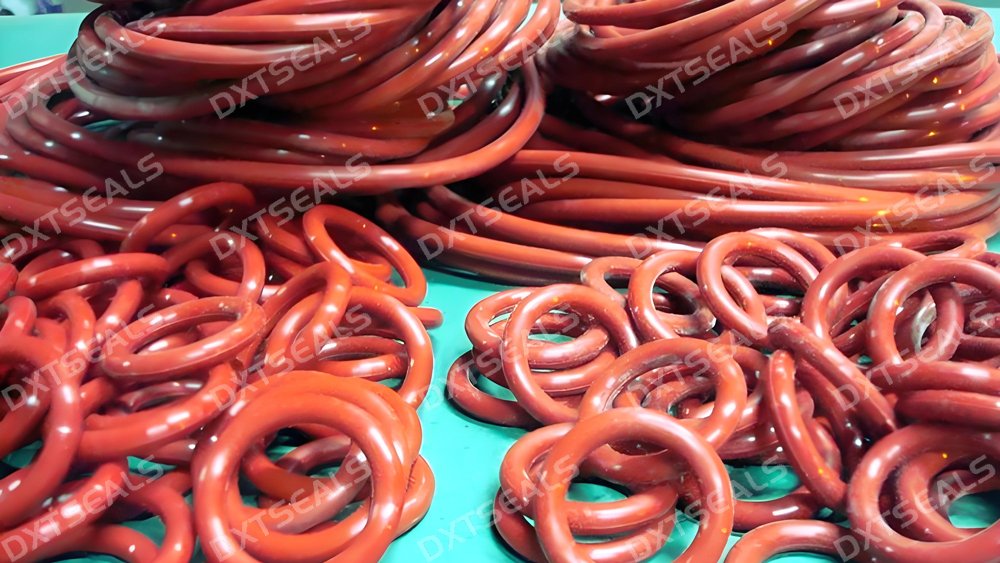
In many industries, sealing components are often exposed to corrosive chemicals, strong acids, alkalis, or oil-based fluids. Selecting the wrong material can lead to swelling, hardening, cracking, or total seal failure.
In this guide, DXTSEALS compares the chemical resistance of common rubber materials and provides recommendations for different working environments.
🔍 1. Understanding Chemical Resistance in Rubber Materials
Chemical resistance refers to a material’s ability to maintain its physical and sealing properties when exposed to specific chemicals over time. Factors that affect resistance include:
-
Chemical type and concentration
-
Operating temperature
-
Exposure time and frequency
-
Material composition and additives
🧪 2. Common Rubber Materials and Their Chemical Resistance
| Material | Strong Acid Resistance | Strong Alkali Resistance | Oil & Fuel Resistance | Notable Weaknesses |
|---|---|---|---|---|
| NBR (Nitrile) | Poor | Fair | Excellent | Poor ozone & weather resistance |
| HNBR | Fair | Good | Excellent | Not suitable for strong oxidizing acids |
| FKM (Viton®) | Good (moderate acids) | Fair | Excellent | Limited in low temps |
| EPDM | Excellent | Excellent | Poor | Attacked by petroleum oils |
| VMQ (Silicone) | Fair | Good | Fair | Swells in oils and fuels |
| PTFE | Excellent | Excellent | Excellent | Low elasticity, needs backup |
🌡 3. Choosing Materials for Specific Chemical Environments
Strong Acid Environments (e.g., Sulfuric Acid, Hydrochloric Acid)
-
Best Choice: PTFE, EPDM (for moderate acids), FKM (for mild acids)
-
Avoid: NBR, VMQ
Strong Alkali Environments (e.g., Sodium Hydroxide, Potassium Hydroxide)
-
Best Choice: PTFE, EPDM
-
Avoid: NBR, FKM (limited alkali resistance)
Oil and Fuel Environments (e.g., Hydraulic Oil, Diesel, Gasoline)
-
Best Choice: NBR, HNBR, FKM, PTFE
-
Avoid: EPDM, VMQ
📊 4. Quick Material Selection Table
| Application Condition | Recommended Material |
|---|---|
| Concentrated acid handling at 80°C | PTFE |
| Alkali washing systems | EPDM or PTFE |
| Oil seals for hydraulic pumps | NBR or HNBR |
| Chemical pumps with mixed acids & solvents | FKM or PTFE |
| Outdoor chemical storage gaskets | EPDM or PTFE |
🛠 5. Additional Selection Tips
-
Check concentration and temperature – higher concentration or temperature can reduce resistance.
-
Consider mechanical requirements – PTFE is chemically resistant but may require an elastomer backup for sealing elasticity.
-
Test before mass use – always validate performance with small-scale trials.
-
Account for combined exposure – chemicals, temperature, and pressure can interact to degrade seals faster.
💡 Conclusion
The best chemical-resistant rubber material depends on both the chemical type and the operating environment.
-
EPDM excels in strong acids and alkalis but is unsuitable for oil.
-
NBR and HNBR are oil champions but weak in aggressive chemicals.
-
FKM offers balanced performance for many oils, fuels, and mild acids.
-
PTFE stands out with near-universal chemical resistance.
At DXTSEALS, we supply custom seals, O-rings, and gaskets in NBR, HNBR, FKM, EPDM, VMQ, and PTFE, ensuring your equipment gets the right material for maximum service life.
📩 Contact DXTSEALS for expert material selection support for chemical sealing applications.
